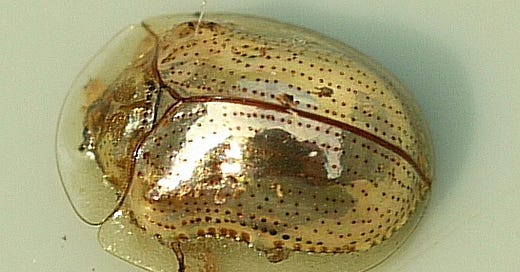All That Glitters
Today’s special animal friend is the Golden Tortoise Beetle, Charidotella sexpunctata, which was suggested by MarqueG after he read something about it on X. I didn’t know it existed, so that’s cool. They are widely distributed in North and Central America. It is in the “leaf beetles” family, Chrysomelidae, and in some places, such as Missouri, it is known as the “sweet potato leaf beetle.” They are 0.2–0.3 inches long and circular or slightly oval in shape. Adults, when they are happy, are a bright, shiny gold color.
It has a sort of transparent shield, as you see. “Elytral margins are expanded and nearly transparent,” says Wikipedia. “The elytra are the two large sclerites posterior to the pronotum, which cover the wings. The elytral margin is found at the lateral edge of each elytron,” says the poorly named “LucidCentral.” That is to say, the elytra are the wing covers on beetles, and these ones have a transparent edge all around. “The pronotum shield completely covers the top of the head.” “The pronotum is a prominent plate-like structure that covers all or part of the thorax of some insects. The pronotum covers the dorsal surface of the thorax,” says the Entomological Society, and in this case, it covers the head and extends past it, transparently.
The color is variable. Juveniles are reddish brown, and adults’ color changes during mating and when they are disturbed, such as when a graduate student is measuring them. Scientists don’t know why this is, but it might be related to hydration.
These insects eat the leaves of plants in the Convolvulaceae family, which includes bindweeds, morning glories, and sweet potatoes. Females are found on the stems and under the leaves of the plants they eat. In five or ten days, they hatch into spiny larvae. As they grow, the larvae use a body part called an anal fork to carry around a pile of their own droppings and shed skins. This protects them from some predatory insects. Eventually, they pupate in their pile of frass; the adult beetle emerges from the pupa in one to two weeks.
The complete life cycle, from egg to adult to death, lasts less than a month. Predators include spiders, ladybugs and other beetles, lizards, and rodents. The adult beetle can press itself to a leaf with its extremities tucked under its domed back, making it difficult for a predator to grasp it. This is the origin of the name “tortoise beetle.” They can also be the victims of parasitic wasps.
Although beetles of this kind chew holes in the leaves of their host plants, they are not found in large swarms, and they rarely damage plants’ health significantly.




Good morning, everyone. They Say it will be 70 today.
That is one beautiful beetle! The prettiest we get are the Japanese beetles and their beauty is tarnished because they are so destructive. One time I was driving the family home from up north and my husband was in the passenger seat. He looked over at me and said “don’t move!” Of course I freaked out and started swatting myself all over knowing that there was something on me. It was just a Japanese beetle. He could’ve just said it.